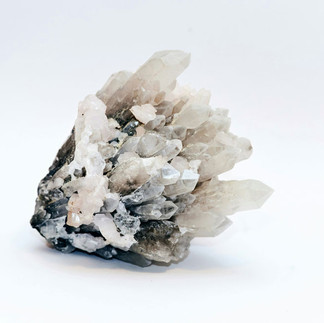The Silent Strengthener: How Silica Fortifies Your Cannabis Plant From the Inside Out
- Cannabis Cactus

- Jul 25
- 5 min read

Silica is not often the first nutrient growers think of when feeding cannabis, yet its impact is both structural and strategic. Composed primarily of silicon dioxide (SiO₂), this elemental compound is more than just a grain in the desert—it’s a cellular architect, a defensive shield, and a silent partner in nutrient uptake. While it’s not classified as an essential nutrient, its consistent inclusion in feeding regimens has become increasingly respected, especially among those seeking resilient, high-performing plants.
Cannabis, much like bamboo or rice, thrives when silicon is available. Although it’s not always present in commercial soil mixes or bottled nutrient solutions, silica acts as a critical reinforcer for the plant’s infrastructure. In cannabis, this means stronger stems, thicker leaves, and a more upright posture—all of which create a more efficient canopy for light absorption and airflow.
At the cellular level, silica is integrated into the cell walls of the plant, enhancing rigidity and resistance. The fortified walls serve not only as skeletal support but also as a deterrent to environmental stress. Just as rebar strengthens concrete, silica reinforces the very scaffolding that supports plant growth. In outdoor gardens or harsh desert climates, where wind and temperature fluctuations are daily events, this added resilience is invaluable.
Pest resistance is another key benefit. With silica-laden cells, soft-bodied insects such as aphids, thrips, and spider mites encounter a less appetizing terrain. Leaf tissue becomes tougher to pierce and digest, subtly tipping the odds in the grower’s favor without resorting to harsh pesticides. Additionally, some studies suggest that silica may prime the plant’s natural immune responses, increasing the production of phytoalexins and other defense-related compounds.
Beyond defense, silica plays a less obvious but equally vital role in nutrient uptake. By regulating the transport of other minerals across cell membranes, silica helps optimize the internal distribution of potassium, calcium, magnesium, and even phosphorus. This function is especially useful in high-stress scenarios, such as heat waves, drought, or transplant shock, when nutrient uptake is typically compromised. In hydroponic systems, where nutrient availability is highly controlled, silica can offer a safety net against these imbalances.
Root development also benefits from consistent silica supplementation. A robust root zone translates to increased nutrient absorption, oxygen exchange, and overall stability. Silica enhances root cell integrity, making the subterranean network more capable of surviving pathogenic threats like root rot and pythium. In container gardens or high-humidity environments, this advantage can mean the difference between survival and collapse.
When it comes to dosing, not all silica sources are created equal. Most common formulations include potassium silicate or sodium silicate. These are typically added to the water early in the feeding schedule, as silica can precipitate out or become locked out when mixed improperly with other nutrients. It’s wise to add silica first, allow it to fully dilute, and then follow with base nutrients and supplements. Organic growers often prefer natural forms like horsetail tea or diatomaceous earth, though their availability and consistency may vary. I dilute about 2 1/2 to 5 mL per gallon nearly every watering and feeding during the vegetation season. Always measure the pH of water nutrient solutions. I like to be dialed in at 6.5 pH. Between 6-7 pH is considered acceptable.
Timing is everything with silica. The early vegetative stage is the best time to start feeding it, as this is when the plant is actively building its framework. Applying silica later in flower can still be beneficial, but most of the structural development has already taken place. In fact, excess silica in late bloom may interfere with flavor and terpene expression if not managed carefully.
One of the more subtle impacts of silica is its influence on water regulation. It assists the plant in maintaining turgor pressure, the internal cell pressure that keeps leaves and stems firm. In hot conditions, this means plants are less likely to wilt or suffer from heat stress. Silica essentially functions as an internal coolant, helping to regulate the plant’s response to environmental extremes.
In the wild, cannabis doesn’t always have access to high levels of bioavailable silica. Cultivated environments, particularly indoor grows and sterile media setups, remove this natural buffer. For this reason, growers interested in replicating the ruggedness of outdoor-grown plants would do well to incorporate silica into their nutrient regimen.
Silica reminds us that strength isn’t always loud or visible. It’s the internal armor, the undercurrent of durability that separates a plant that merely grows from one that thrives. Whether in a sun-soaked backyard or a sealed grow tent under LEDs, cannabis plants fortified with silica become more than just survivors; they become botanical warriors. Feeding cannabis silica isn’t a trendy add-on. It’s a foundational practice for those aiming for resilience, quality, and the satisfaction of knowing their garden can hold its own even when nature doesn’t play nice.
Silica plays a surprisingly essential role in human health. Known scientifically as silicon dioxide, this trace mineral is present in our bones, skin, hair, nails, and connective tissues. Though not as widely promoted as calcium or magnesium, silica is foundational for strength, elasticity, and repair throughout the body. Its quiet presence supports structure and longevity in ways that mirror its benefits in plants.
In the human body, silica is integral to collagen synthesis. Collagen is the most abundant protein in the body, forming the scaffolding for skin, joints, blood vessels, and even internal organs. Silica helps to stabilize the collagen matrix and supports its production, particularly during growth or repair phases. A diet rich in bioavailable silica can contribute to firmer, more elastic skin, stronger nails, and thicker, shinier hair. For this reason, many beauty supplements and functional waters now contain added silica from sources like bamboo extract or horsetail herb.
Bone health is another area where silica shines. While calcium gets most of the attention, silica facilitates calcium’s assimilation into bone tissue. It acts as a delivery agent, ensuring that calcium and magnesium are deposited correctly and efficiently. Research has suggested that silica deficiency may contribute to brittle bones or slower healing after fractures. In fact, early studies on osteoporotic women showed that those supplementing with silica alongside other minerals experienced improved bone density compared to those taking calcium alone.
Silica also has a unique relationship with detoxification. Its molecular structure gives it an absorptive quality, allowing it to bind with heavy metals and other unwanted compounds in the gut and bloodstream. This ability makes silica-rich clays and diatomaceous earth popular in internal cleansing regimens. When used appropriately, they can help flush out aluminum, lead, and other toxic metals that disrupt metabolic function and cognitive clarity.
Cardiovascular support is another lesser-known benefit. Silica strengthens arterial walls and helps maintain the flexibility of blood vessels. This can contribute to improved circulation and reduced risk of hypertension or arterial plaque buildup. Studies have even linked silica intake to reduced atherosclerosis risk, further cementing its role in vascular resilience.
Unlike many synthetic supplements, silica is widely available in natural foods: cucumbers, oats, bananas, leafy greens, and especially mineral-rich spring waters. Still, modern diets—often filled with processed foods and depleted soils—can fall short. Supplementing with a bioavailable silica source may offer a simple but powerful way to enhance your structural health from the inside out.
What’s Good for Us Is Good for the Plants
Whether reinforcing the cell walls of a cannabis plant or supporting the collagen matrix in human tissues, silica serves as a universal builder. It enhances strength, resilience, and vitality across both plants and humans. Just as our bones, skin, and joints rely on silica for flexibility and structure, cannabis uses it to stand tall, resist pests, and absorb nutrients with efficiency. The parallel is clear: nature doesn’t waste a good idea. Silica is one of those rare compounds that bridges biology, benefitting life wherever it’s allowed to do its work. Feed your body. Feed your plants. Let the strength flow both ways.


















Comments